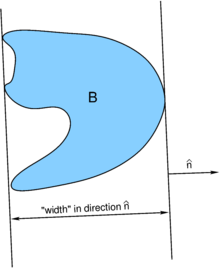In geometry, the mean width is a measure of the "size" of a body; see Hadwiger's theorem for more about the available measures of bodies. In dimensions, one has to consider -dimensional hyperplanes perpendicular to a given direction in , where is the n-sphere (the surface of a -dimensional sphere). The "width" of a body in a given direction is the distance between the closest pair of such planes, such that the body is entirely in between the two hyper planes (the planes only intersect with the boundary of the body). The mean width is the average of this "width" over all in .

More formally, define a compact body B as being equivalent to set of points in its interior plus the points on the boundary (here, points denote elements of ). The support function of body B is defined as
where is a direction and denotes the usual inner product on . The mean width is then
where is the -dimensional volume of . Note, that the mean width can be defined for any body (that is compact), but it is most useful for convex bodies (that is bodies, whose corresponding set is a convex set).
Mean widths of convex bodies in low dimensions
One dimension
The mean width of a line segment L is the length (1-volume) of L.
Two dimensions
The mean width w of any compact shape S in two dimensions is p/π, where p is the perimeter of the convex hull of S. So w is the diameter of a circle with the same perimeter as the convex hull.
Three dimensions
For convex bodies K in three dimensions, the mean width of K is related to the average of the mean curvature, H, over the whole surface of K. In fact,
where is the boundary of the convex body and a surface integral element, is the mean curvature at the corresponding position on . Similar relations can be given between the other measures and the generalizations of the mean curvature, also for other dimensions . As the integral over the mean curvature is typically much easier to calculate than the mean width, this is a very useful result.
See also
References
- Jiazu, Zhou; Deshuo, Jiang (2008), "On mean curvatures of a parallel convex body", Acta Mathematica Scientia, 28 (3): 489–494, doi:10.1016/S0252-9602(08)60050-8
Further reading
The mean width is usually mentioned in any good reference on convex geometry, for instance, Selected topics in convex geometry by Maria Moszyńska (Birkhäuser, Boston 2006). The relation between the mean width and the mean curvature is also derived in that reference.
The application of the mean width as one of the measures featuring in Hadwiger's theorem is discussed in Beifang Chen in "A simplified elementary proof of Hadwiger's volume theorem." Geom. Dedicata 105 (2004), 107—120.
Category: dimensions, one has to consider
dimensions, one has to consider  -dimensional hyperplanes perpendicular to a given direction
-dimensional hyperplanes perpendicular to a given direction  in
in  , where
, where  is the
is the  -dimensional sphere).
The "width" of a body in a given direction
-dimensional sphere).
The "width" of a body in a given direction  ). The support function of body B is defined as
). The support function of body B is defined as

 denotes the usual inner product on
denotes the usual inner product on 
 is the
is the 
 is the boundary of the convex body
is the boundary of the convex body  and
and  a surface integral element,
a surface integral element,  is the
is the